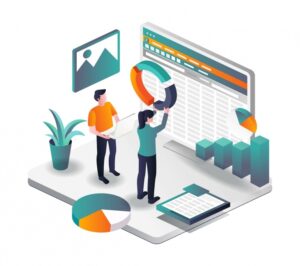
Australian organizations have reported seeing a healthy two-times return on investment from their efforts to improve tech stack observability, but they’re struggling under the weight of too many observability tools and are dealing with a comparatively large proportion of siloed data.
The Observability Forecast 2023 from provider New Relic found Australasian organizations are high adopters of observability. It found 43% of those surveyed in Australia and 41% in New Zealand have at least 10 of 17 key observability capabilities deployed in their organizations.
However more than half (54%) of organizations surveyed were using five or more tools for observability, much higher than the 39% doing so in North America, and Australian and New Zealand organizations also had far more siloed telemetry data (49%) than unified (28%).
Jump to:
The characteristics and capabilities of observability best practice
Today’s observability best practice involves instrumenting systems to surface insights from telemetry data (metrics, events, logs and traces), so various roles can take action on issues and errors that impact customer experience and service, such as outages. New Relic says the best users also collect, analyse, alter and correlate data to improve their uptime and performance.
SEE: Splunk offers insight on the state of observability.
In essence, observability provides ” … visibility across your network, infrastructure, systems, application, database, digital experience, and log monitoring,” according to a Lessons From Observability Leaders report from observability provider SolarWinds.
Both vendors suggest the goal would be to do all this within one platform, though many currently use multiple tools.
“IT environments are now too complex for humans to manage alone,” the SolarWinds report said. “Observability tools have emerged as a solution for achieving optimal performance … (and go) a step beyond monitoring, using cross-domain data correlation, machine learning, and AIOps to provide actionable business insights needed to identify and remediate issues in real time.”
Observability capabilities and global deployment levels
New Relic’s report measured organizations around the world across 17 key observability capabilities. The report said organizations had full-stack observability if they had deployed ” … specific combinations of observability capabilities, including customer experience monitoring/DEM (frontend), services monitoring, log management, environment monitoring (backend), and security monitoring.”
| Capability | Description | Deployment |
|---|---|---|
| AIOps | Uses AI to improve IT processes and gain insights. | 41% |
| Alerts | Provides notifications triggered by an important event, such as an error. | 66% |
| Application performance monitoring (APM) | Monitors applications for performance and errors. | 53% |
| Browser monitoring | Tracks browser and web application activity and performance. | 55% |
| Dashboards | Provides an overview of important monitoring metrics. | 65% |
| Database monitoring | Gathers essential performance metrics to measure and optimize database performance. | 68% |
| Distributed tracing | Tracks and observes service requests as they flow through distributed systems. | 29% |
| Error tracking | Tracks and traces errors to troubleshoot issues. | 50% |
| Infrastructure monitoring | Monitors network infrastructure like servers. | 65% |
| Kubernetes monitoring | Monitors Kubernetes (K8s) deployments by providing visibility into clusters and workloads. | 29% |
| Log management | Stores and searches error and event logs. | 62% |
| Machine learning model performance monitoring | Monitors machine-learning-model performance. | 29% |
| Mobile monitoring | Monitors mobile application and device performance. | 41% |
| Network monitoring | Monitors network traffic and performance metrics. | 74% |
| Security monitoring | Collects and analyses vulnerability indicators of potential security threats. | 75% |
| Serverless monitoring | Monitors serverless application performance metrics and errors. | 32% |
| Synthetic monitoring | Monitors simulated usage to predict performance. | 23% |
Table: New Relic Observability Forecast 2023
Multiple tools a barrier to full-stack observability dream
Australian and New Zealand organizations plan to continue embracing observability. New Relic data suggests 77% of organizations expect to deploy two or more new capabilities next year, and 52% were investing in training their staff on best practice use of observability tools.
However, 20% of respondents in Australasia said too many monitoring tools were a primary challenge to them achieving full-stack observability. New Relic said this reflected their stronger preference for a single consolidated platform (54%) over multiple point solutions (28%).
SEE: Discover what makes observability a priority.
European and North American organizations are also more likely to prefer a single consolidated platform. Comparatively, North American organizations have better consolidated their tools. Only 39% use five or more tools, down from 73% in 2022, while 48% plan to consolidate further next year.
Australia and New Zealand may follow the consolidation trend. In 2023, 6% of respondents are using one tool, compared with none last year. Almost half (46%) of respondents also plan to consolidate tools over the next year to get the most value from their observability spend.
Siloed data adding to full-stack observability challenge
Just 18% of local Australasian organizations said their telemetry was captured across the full tech stack, which is notably lower than the global average of 24%. As mentioned above, 49% said they had more siloed telemetry data than unified (28%).
Less than a third of respondents could say their users broadly had access to telemetry data and visualizations (31%) and that it was unified in a single pane for consumption by teams (31%). Further, 18% said siloed data was a primary challenge to achieving full-stack observability.
Australia seeing strong return on observability investments
The biggest focus of observability efforts in Australia and New Zealand is security monitoring (84%), followed by network monitoring (76%) and dashboards (74%). Local companies have been least invested in synthetic monitoring (20%) and Kubernetes monitoring (24%).
New Relic called deployment plans for next year “ambitious,” with 38% to implement distributed tracing, 36% machine learning model performance monitoring, 35% serverless monitoring and 28% AIOps. Only 15% of local organizations did not plan any new capabilities.
SEE: Discover how AI and observability can improve performance in IT operations.
The most popular strategies or trends driving observability uptake in Australasia are:
- Increased focus on security, governance, risk and compliance (43%).
- Migration to a multicloud environment (41%).
- Increased focus on customer experience management (37%).
Observability may help mitigate the cost of outages. Thirty four percent of respondents in Australasia have high-business-impact outages once per week or more. In New Zealand, this adds up to an annual median outage cost of US $8.5 million (NZ $13.3 million). In Australia, the annual cost was US $7.37 million (AU $11.6 million) per year for those surveyed.
Reaping the benefits of a better view across the tech stack
Australian organizations realised a two-times return on observability investments — though New Zealand companies only broke even. In Australian organizations, 29% of executives said their organization receives a total annual value of AU $1 million (US $640,000) or more.
The top observability benefits being seen were increased operational efficiency (42%), improved system uptime and reliability (36%), and security vulnerability management (36%). A full 62% said their mean time to repair had improved to some degree since adopting observability.
This is keeping advocacy high among C-level executives. In Australia and New Zealand, 74% of the more technical-focused executives were seen as advocates of observability, though advocacy among less technical-focused executives dropped to 73% (from 83% in 2022).
Executives said the key advantages of observability for them in their daily lives were the help it gave in prioritizing environment updates and new service rollouts (37%), establishing a technology strategy (34%), and achieving business (34%) and technical (31%) KPIs.
Source of Article



